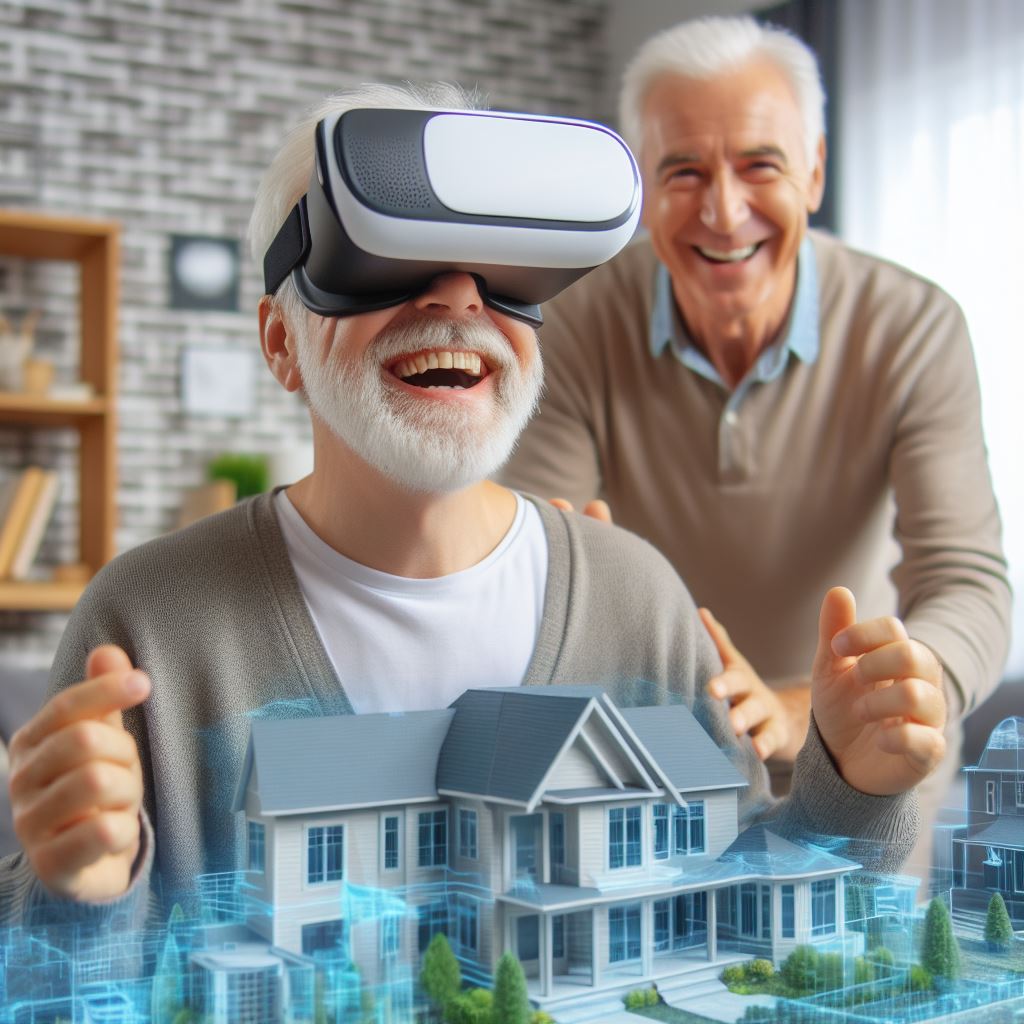Introduction
Virtual Reality (VR) is making waves in the real estate industry, transforming it in ways never imagined before.
This innovative technology has the potential to revolutionize the sector, and this blog post aims to explore its impact.
The real estate industry has traditionally relied on physical visits to properties, which can be time-consuming and inconvenient for both buyers and sellers.
However, with the advent of VR, this is changing rapidly.
Virtual tours allow potential buyers to explore properties from the comfort of their own homes.
VR offers a level of immersion and interactivity that traditional methods cannot match.
Buyers can virtually walk through properties, examine every detail, and even visualize renovations or interior design changes.
This enhances the buying experience and can help buyers make more informed decisions.
Moreover, VR can save time and money for real estate agents and developers.
Instead of organizing multiple physical open houses, they can showcase properties virtually to a larger audience.
This means that potential buyers from anywhere in the world can explore properties without the need for travel.
Additionally, VR can streamline the construction process by allowing architects and designers to visualize and modify plans in a virtual environment.
This can help identify potential issues before construction begins, saving time and resources.
In fact, the rise of VR in the real estate industry is nothing short of revolutionary.
It offers a transformative and immersive experience for buyers, while also streamlining processes for sellers and developers.
The blog post aims to delve deeper into this topic and highlight the immense potential of VR in revolutionizing the real estate sector.
Definition of Virtual Reality
Virtual Reality (VR) is a cutting-edge technology that immerses users in a computer-generated environment, blurring the lines between the physical and digital worlds.
In the realm of real estate, VR is ushering in a revolution by reshaping the way we perceive, experience, and interact with properties.
This transformative technology goes beyond traditional 2D images and floor plans, allowing potential buyers to virtually step inside a property and explore every nook and cranny.
What Virtual Reality Entails
VR creates an artificial, three-dimensional environment that users can explore and interact with using specialized hardware, such as VR headsets or immersive displays.
This technology engages multiple senses, providing a sense of presence and realism.
In the context of real estate, it enables potential buyers to tour homes, apartments, or commercial spaces from the comfort of their own homes, transcending geographical barriers.
Overview of How Virtual Reality Works
The magic of VR lies in its ability to simulate a lifelike experience.
VR systems utilize a combination of sensors, motion tracking, and computer graphics to create an immersive environment.
As users move their heads or bodies, the system responds in real-time, adjusting the virtual surroundings accordingly.
High-quality visuals, spatial audio, and haptic feedback further enhance the sense of immersion, making users feel as though they are physically present in the virtual space.
Examples of Virtual Reality in Other Fields and Industries
VR has already made significant strides in various industries, proving its versatility.
In healthcare, surgeons practice procedures in a risk-free virtual environment, while in education, students embark on virtual field trips.
The gaming industry has embraced VR for a more immersive gaming experience.
These examples showcase the potential of VR to revolutionize experiences across diverse fields.
In the real estate sector, VR is poised to redefine property viewing, enabling potential buyers to explore homes remotely.
This technology eliminates the need for physical visits, saving time and resources while providing a more engaging and efficient way to make informed decisions about real estate investments.
As the boundaries between the physical and virtual worlds continue to blur, the real estate landscape is on the brink of a transformative revolution driven by the power of Virtual Reality.
Read: Expert Valuation: Appraising Properties
Virtual Reality in Real Estate: A Game-Changer
In recent years, Virtual Reality (VR) has emerged as a transformative force in various industries, and the real estate sector is no exception.
The integration of VR technology has revolutionized the way properties are marketed, explored, and sold, creating a paradigm shift in the real estate landscape.
How Virtual Reality is transforming the real estate industry
Virtual Reality in real estate provides a dynamic and immersive experience, allowing potential buyers to virtually tour properties from the comfort of their homes.
This innovation eliminates the limitations of traditional property viewings and enables a global audience to explore listings without geographical constraints.
Real estate professionals can now showcase properties in an interactive 3D environment, providing a more comprehensive understanding of the space and its potential.
Benefits of Virtual Reality for real estate professionals and customers
For real estate professionals, the benefits are manifold.
Virtual Reality facilitates efficient property marketing by creating engaging and realistic virtual tours.
Agents can conduct virtual open houses, reaching a broader audience and saving time for both themselves and their clients.
Additionally, VR aids in pre-qualifying leads, as potential buyers can gauge their interest in a property before scheduling an in-person visit.
Customers, on the other hand, enjoy the convenience of exploring multiple properties without physically traveling to each location.
VR enables them to make informed decisions based on detailed virtual walkthroughs, fostering a more engaging and informed home-buying experience.
Enhanced visualization and immersive experiences
One of the key advantages of VR in real estate is the enhanced visualization it provides.
Prospective buyers can virtually walk through properties, inspecting details with a level of precision that traditional photographs or videos cannot offer.
This heightened sense of presence and immersion allows clients to envision themselves in the space, leading to more confident purchasing decisions.
In fact, Virtual Reality is undeniably a game-changer in the real estate industry.
Its ability to transform property showcasing, enhance visualization, and provide immersive experiences benefits both real estate professionals and customers alike.
As technology continues to advance, the integration of Virtual Reality is poised to become a standard practice, ushering in a new era of efficiency and innovation in the world of real estate.
Read: Artificial Intelligence in Home Staging
Virtual Reality for Property Developers
In the ever-evolving landscape of real estate, Virtual Reality (VR) emerges as a groundbreaking tool, revolutionizing property development processes.
Property developers are increasingly leveraging VR to transform the way they design, plan, and showcase properties, ultimately leading to cost-saving benefits and optimized decision-making.
Utilizing Virtual Reality in property development Processes
One of the most significant advantages of VR for property developers is its ability to enhance the entire development process.
Through immersive experiences, developers can visualize and manipulate every aspect of a project before breaking ground.
This technology allows for more informed decision-making during the design phase, leading to efficient use of resources and minimizing costly revisions.
Designing, planning, and showcasing properties through Virtual Reality
In the realm of property development, designing and planning are crucial stages.
VR provides a three-dimensional canvas for architects and planners to bring their visions to life.
Developers can virtually walk through spaces, adjusting layouts and exploring various design elements in real-time.
This not only accelerates the planning process but also fosters collaboration among stakeholders, ensuring everyone is on the same page from the early stages of development.
The power of VR extends beyond the planning phase into property showcasing.
Potential buyers can now experience a property without physically being there.
Virtual property tours offer an immersive experience, allowing users to explore every nook and cranny of a development.
This not only saves time for both developers and clients but also opens up properties to a global audience, attracting interest from investors and buyers worldwide.
Cost-saving benefits and optimizing decision-making
The cost-saving benefits of VR in property development are undeniable.
Reducing the need for physical prototypes and models, developers can cut down on production costs significantly.
Moreover, VR enables quick and efficient decision-making by allowing developers to identify and rectify potential issues before they become expensive problems.
Basically, Virtual Reality is not just a technological marvel; it’s a game-changer for property developers.
By integrating VR into their processes, developers can streamline design, planning, and showcasing efforts, leading to substantial cost savings and more informed decision-making.
As the real estate industry continues to embrace innovation, VR stands at the forefront, shaping the future of property development.
Read: Accurate Property Valuation: How To

Virtual Reality for Real Estate Agents
Virtual Reality (VR) technology has revolutionized the real estate industry, providing a range of benefits for both agents and their clients.
Let’s delve into how VR is dramatically enhancing the customer experience, offering virtual property tours, and saving time for all parties involved.
Enhancing the Customer Experience
Virtual Reality has taken customer experiences to new heights by transporting potential buyers into a virtual world.
With the help of VR headsets, clients can virtually tour properties without leaving their homes.
They can explore every corner of the house, visualize floor plans, and get an immersive sense of the property.
This enhanced experience allows clients to make more informed decisions, speeding up the buying process.
Real estate agents can showcase multiple properties to clients, eliminating the need for endless physical tours and reducing the chances of disappointment.
Virtual Property Tours
With Virtual Reality, real estate agents can provide incredible virtual property tours to potential buyers remotely.
Agents can create realistic 3D renderings of properties, allowing clients to explore every detail from any location.
By utilizing VR, agents can offer a realistic representation of properties, including the surrounding neighborhood.
Clients can visualize how the property would fit into their lifestyle and determine if it meets their expectations before scheduling an in-person tour.
Increased Reach and Time Savings
Virtual Reality has expanded the reach of real estate agents, breaking geographical barriers.
Agents can cater to clients from across the globe by offering immersive virtual tours through VR technology.
This increased reach translates to potential buyers saving time and resources.
Instead of traveling to multiple locations for property visits, interested buyers can explore various properties virtually from the comfort of their homes.
Furthermore, agents can streamline the process by filtering out properties that don’t align with clients’ preferences.
This way, both parties save time by focusing only on properties that have a higher chance of meeting the clients’ needs.
Virtual Reality has transformed the real estate industry, providing agents with a powerful tool to enhance the customer experience, offer virtual property tours, and save time for all parties involved.
With the immersive nature of VR, clients can visualize properties like never before, resulting in more confident and faster purchasing decisions.
As technology continues to advance, Virtual Reality is expected to become an integral part of real estate, allowing agents and clients to collaborate seamlessly regardless of physical distances.
The future of real estate is now, and VR is leading the way towards a more efficient and interactive property market.
Read: Emerging Trends in Real Estate for 2024
Virtual Reality for Homebuyers
Exploring properties in a virtual environment before physical visits
In the fast-paced world of real estate, where time is of the essence and choices are vast, virtual reality (VR) emerges as a revolutionary tool for homebuyers.
Embracing the immersive capabilities of VR, prospective homeowners can now embark on a journey through properties without stepping foot outside their homes.
Gone are the days of endless property visits and the uncertainty that accompanies them.
This not only saves time but also provides a more efficient and informed decision-making process.
Evaluating layouts, designs, and customizations virtually
One of the most significant advantages of VR in real estate is the ability to evaluate layouts, designs, and customizations virtually.
Homebuyers can virtually walk through each room, assessing the flow of space and envisioning how their furniture and personal touch might fit into the layout.
This level of immersion allows for a more profound connection with the property, enhancing the decision-making process.
The virtual exploration of properties is not limited to a mere walkthrough.
In the VR realm, potential buyers can interact with the environment, customize features, and experiment with various design options.
Want to see how a different color scheme would look in the living room? With VR, it’s just a few clicks away.
This level of personalization ensures that homebuyers can tailor the virtual experience to meet their preferences, making it a powerful tool for refining their choices.
Reducing the number of property visits and effectively narrowing choices
By leveraging VR technology, homebuyers can significantly reduce the number of physical property visits.
The ability to explore multiple homes virtually allows buyers to narrow down their choices efficiently, focusing only on properties that align with their preferences and requirements.
This not only streamlines the decision-making process but also minimizes the environmental impact associated with frequent travel.
Therefore, virtual reality has ushered in a new era for homebuyers, transforming the real estate experience into a dynamic and immersive journey.
From exploring properties in a virtual environment to evaluating layouts and customizations, VR is redefining how individuals find and connect with their dream homes.
Welcome to the future of real estate, where the boundaries between the virtual and physical worlds seamlessly merge for a more informed and efficient homebuying process.
Virtual Reality Challenges and Limitations in Real Estate
Potential hurdles and limitations of implementing Virtual Reality
Virtual Reality (VR) is undeniably transforming the real estate industry, offering immersive experiences that allow potential buyers to virtually explore properties from the comfort of their homes.
However, like any innovative technology, VR in real estate comes with its set of challenges and limitations.
Cost of Virtual Reality technology and equipment
One of the primary obstacles faced by the real estate sector in adopting VR is the cost associated with the technology and equipment.
High-quality VR headsets, cameras, and software can be expensive, making it a substantial investment for real estate professionals.
Small and medium-sized agencies may find it challenging to allocate resources for VR technology, hindering widespread adoption.
Technical issues and challenges related to user experience
Technical issues pose another hurdle in the seamless integration of VR into real estate practices.
While VR experiences aim to be immersive and realistic, technical glitches and limitations in user experience can detract from the overall impact.
From laggy visuals to compatibility issues with various devices, ensuring a consistently smooth and reliable VR experience for potential buyers remains a work in progress.
Moreover, the complexity of creating and maintaining VR content for real estate listings can be daunting.
Developing high-quality virtual tours requires specialized skills and may demand collaboration with VR content creators.
Real estate professionals must grapple with the learning curve associated with these technologies or allocate additional resources to outsource content creation.
Furthermore, accessibility is a key concern. Not all potential buyers may have access to VR devices, creating a digital divide within the market.
The real estate industry needs to address this limitation by providing alternative viewing options for those who may not own VR headsets or have access to compatible devices.
Essentially, while Virtual Reality presents a revolutionary approach to real estate, challenges persist.Future of Virtual Reality in Real Estate
See Related Content: IoT Integration in Modern Real Estate Practices
Find Out More: Client Retention Strategies for Agents
Future of Virtual Reality in Real Estate
Predictions and possibilities for the future of Virtual Reality in real estate
Virtual Reality (VR) has rapidly emerged as a transformative force in the real estate industry, revolutionizing the way properties are showcased and experienced.
As we look ahead, the future of VR in real estate holds immense promise, with exciting predictions and possibilities on the horizon.
Advancements and improvements in Virtual Reality technology
Advancements in VR technology are set to redefine the home buying and selling experience. Imagine touring a potential home from the comfort of your living room, exploring every nook and cranny in vivid detail.
The integration of AI and VR will make property searches more personalized, understanding individual preferences and presenting tailored options.
One of the key predictions is the widespread adoption of VR for remote property viewing.
Prospective buyers will have the ability to tour multiple homes virtually, saving time and resources.
This not only benefits buyers but also sellers, as it expands the reach of their listings to a global audience.
Additionally, VR can enhance collaboration among real estate professionals.
Architects, designers, and developers can collaborate seamlessly on virtual projects, making design decisions and modifications in real-time.
This not only streamlines the construction process but also reduces costs and accelerates project timelines.
The future of VR in real estate extends beyond property tours.
Virtual staging is poised to become a standard practice, allowing buyers to visualize a space with different furnishings and layouts.
This helps in making informed decisions and facilitates quicker property sales.
Potential innovations and applications of Virtual Reality in real estate
Innovations in VR may also lead to the development of immersive neighborhood experiences.
Users can explore local amenities, schools, and infrastructure virtually, providing a comprehensive understanding of the community before making a decision.
Moreover, VR can be a powerful tool for property development.
Developers can create virtual prototypes, allowing them to test different designs and concepts before breaking ground.
This not only minimizes risks but also ensures that the final product meets the expectations of both developers and buyers.
As we eagerly anticipate the future of VR in real estate, the possibilities are limitless.
Conclusion
Virtual Reality has revolutionized the real estate industry in numerous ways.
It has transformed the traditional methods of property viewing and has provided an immersive experience for potential buyers.
Real estate professionals should embrace Virtual Reality as it opens up new possibilities for marketing and selling properties.
By incorporating this technology into their business, they can showcase properties to a wider audience and increase their chances of closing deals.
The future potential of Virtual Reality in the real estate industry is promising.
It will continue to bridge the gap between buyers and properties, making it easier for individuals to make informed decisions.
Therefore, it is crucial for real estate professionals to adapt to this innovative tool and stay ahead of the competition.
By embracing Virtual Reality, they can provide an unparalleled experience to their clients and set themselves apart in the industry.
The revolution is underway, and Virtual Reality is here to stay.
Embrace it, and witness the transformation of the real estate industry.




